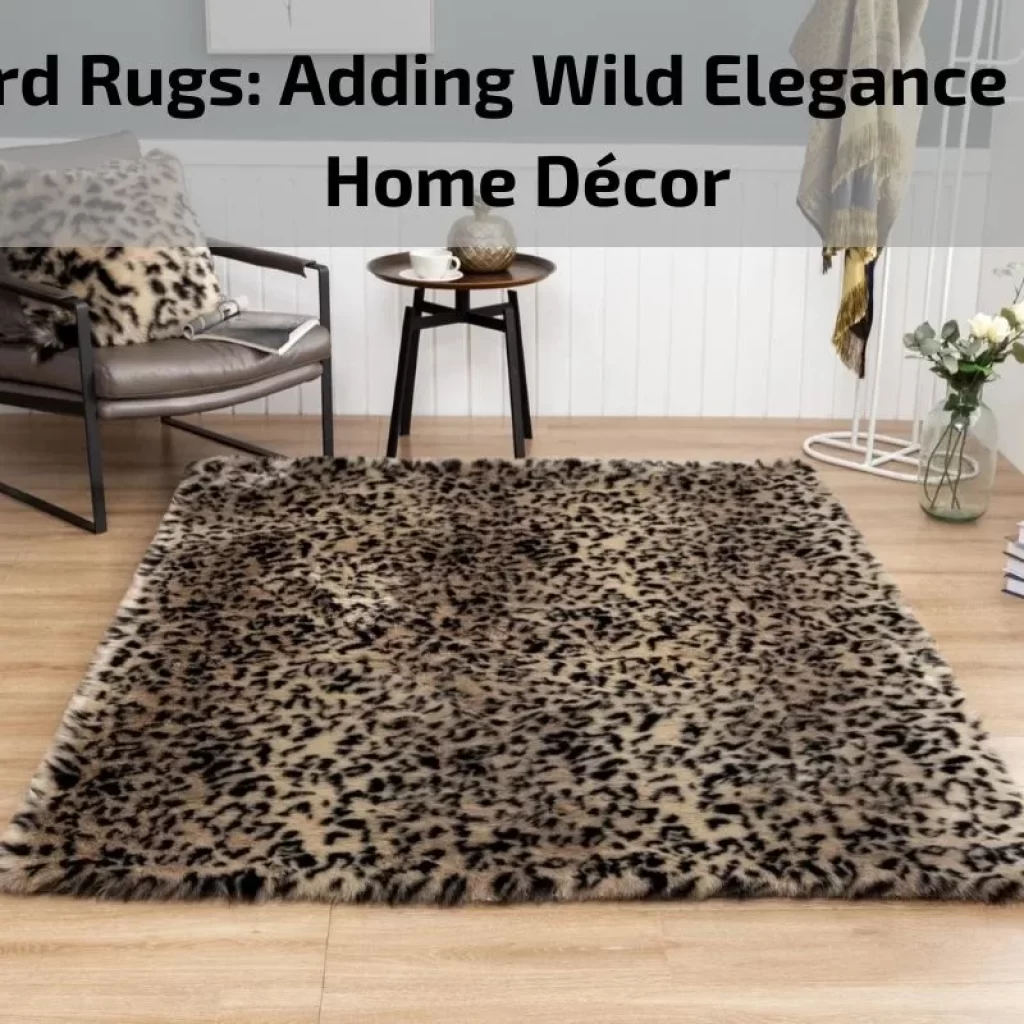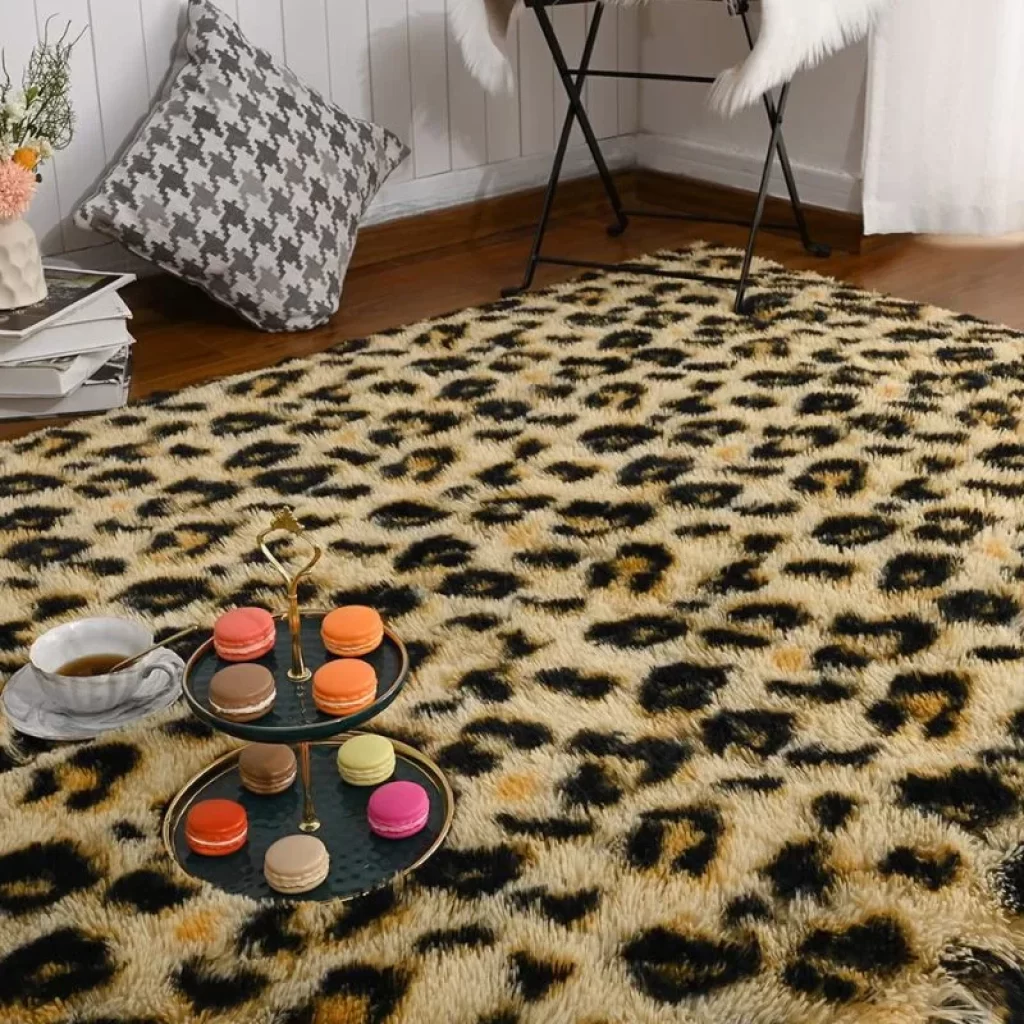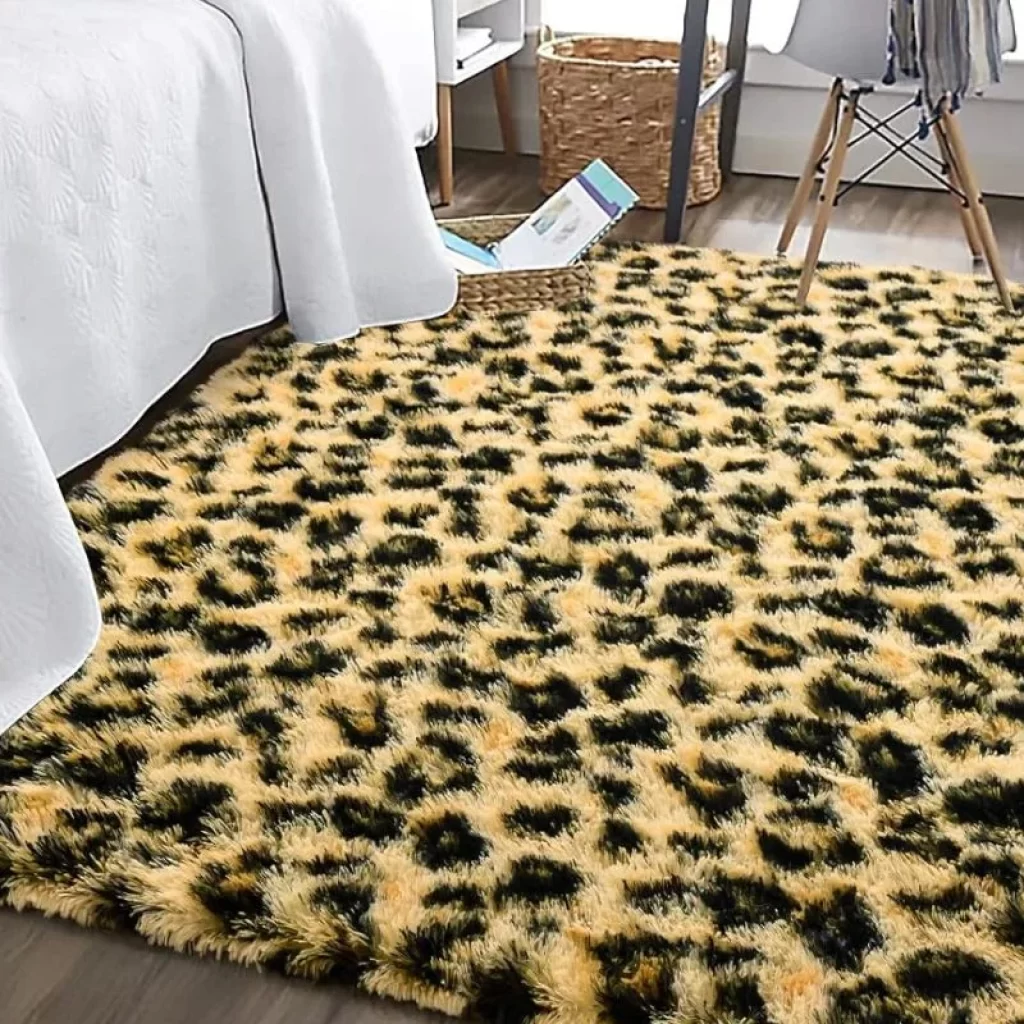Leopard Rugs: Adding Wild Elegance to Your Home Décor

Leopard rugs, with their striking patterns and untamed allure, have long been prized for their ability to infuse a sense of wild elegance into home décor. Originating from the majestic big cats of the savannah, these rugs carry a timeless appeal that transcends trends and styles. Whether used as a focal point or an accent piece, leopard rugs have the remarkable ability to transform any space, adding a touch of luxury and sophistication.
In this article, we will delve into the captivating world of leopard rugs, exploring their history, versatility, and enduring popularity in interior design. From classic motifs to contemporary interpretations, we will uncover the many facets of leopard rugs and discover how they can elevate the ambiance of your living spaces. Join us on a journey through the wilderness of design as we explore the beauty and allure of leopard rugs and learn how they can bring a touch of the exotic into your home.
Brief history and origin of leopard rug motifs
The history and origin of leopard rug motifs can be traced back to ancient times, where the leopard’s distinctive spots and patterns were revered and admired by various cultures around the world. In many ancient societies, the leopard was considered a symbol of power, strength, and royalty, often depicted in artworks, textiles, and decorative items.
One of the earliest known representations of leopard motifs can be found in ancient Egyptian art, where leopards were associated with the goddess Bastet, who was often depicted with the head of a lioness or a domestic cat. Leopards were also depicted in ancient Mesopotamian and Persian art, symbolising royalty and divine protection.
In African cultures, leopards were revered as powerful and cunning hunters, often depicted in tribal art and folklore as symbols of courage, agility, and stealth. Leopard skins were used as symbols of status and prestige among tribal leaders and warriors, signifying bravery and leadership qualities.
During the European Renaissance period, leopard motifs became popular in European art and fashion, influenced by the exploration and trade routes that brought exotic animals and materials from distant lands. Leopard skins were prized as luxurious and fashionable accessories among the European elite, symbolising wealth, exoticism, and sophistication.
In the 20th century, leopard print patterns experienced a resurgence in popularity, especially in the realm of fashion and interior design. Designers and artists began incorporating leopard motifs into textiles, furniture, and home décor items, embracing the bold and glamorous aesthetic associated with the leopard’s distinctive spots and markings.
Today, leopard rugs continue to be celebrated for their timeless elegance, versatility, and visual appeal. Whether used as statement pieces in contemporary interiors or as accents in traditional settings, leopard rugs evoke a sense of luxury, sophistication, and exoticism, making them a beloved and enduring motif in home décor.

Different styles and interpretations of leopard rug designs
Leopard rug designs have evolved over time, offering a range of styles and interpretations to suit various tastes and interior aesthetics. From traditional to modern, here are some popular styles and interpretations of leopard rug designs:
Classic Leopard Print:
Classic leopard print rugs feature the iconic pattern of the leopard’s spots, characterized by irregular black spots on a golden or beige background.
These rugs evoke a sense of timeless elegance and sophistication, making them a versatile choice for both traditional and contemporary interiors.
Realistic Leopard Skin:
Realistic leopard skin rugs aim to replicate the appearance and texture of an actual leopard hide, complete with lifelike markings and shading.
These rugs add a touch of authenticity and natural beauty to interior spaces, capturing the essence of the majestic big cat in stunning detail.
Abstract Leopard Patterns:
Abstract leopard pattern rugs offer a contemporary twist on traditional leopard motifs, featuring stylized interpretations of the leopard’s spots and markings.
These rugs often incorporate geometric shapes, bold lines, and abstract forms to create visually striking and modern designs that complement contemporary décor.
Color Variations:
Leopard rugs are available in a variety of color variations beyond the classic golden and black combination. Some rugs feature muted tones like taupe, gray, or brown, offering a more subdued and understated look.
Alternatively, vibrant color combinations such as blue, green, or red may be used to create bold and eye-catching leopard rug designs that serve as focal points in eclectic or contemporary interiors.
Textured Leopard Rugs:
Textured leopard rugs add dimension and tactile interest to interior spaces, incorporating plush materials like wool, silk, or faux fur to mimic the softness and warmth of a leopard’s coat.
These rugs provide a luxurious and inviting feel underfoot while enhancing the visual appeal of the room with their rich texture and tactile qualities.
Minimalist Interpretations:
Minimalist leopard rug designs strip down the traditional leopard motif to its essential elements, focusing on simplicity, clean lines, and negative space.
These rugs offer a modern and understated take on leopard print, ideal for contemporary interiors seeking a touch of sophistication and style.
By exploring these different styles and interpretations of leopard rug designs, homeowners and interior designers can find the perfect rug to complement their decor preferences and elevate the aesthetic appeal of their living spaces.
Choosing the Perfect Leopard Rug
Selecting the ideal leopard rug for your space involves considering various factors such as size, material, style, and placement. Here are some tips to help you choose the perfect leopard rug:
Determine the Size:
Measure the area where you intend to place the rug to determine the appropriate size. Consider whether you want the rug to cover a specific area, such as under a coffee table or in the center of the room, or if you prefer it to fill the entire space.
Consider the Material:
Leopard rugs come in a variety of materials, including wool, synthetic fibers, silk, and faux fur. Consider the durability, texture, and maintenance requirements of each material to find one that suits your lifestyle and preferences.
Assess the Style:
Choose a leopard rug style that complements your existing décor and aesthetic preferences. Whether you prefer a classic leopard print, a realistic depiction of leopard skin, or a modern abstract interpretation, select a style that enhances the overall look and feel of your space.
Determine the Color Palette:
Leopard rugs are available in a range of color palettes, from traditional golden and black tones to more contemporary variations. Consider the existing color scheme of your room and choose a rug color that harmonizes with the surroundings while making a statement.
Think About Placement:
Decide where you want to place the leopard rug within your space. Whether it’s in the living room, bedroom, dining area, or hallway, consider how the rug will interact with other furniture and décor elements to create a cohesive and visually appealing arrangement.
Assess the Budget:
Leopard rugs come in a wide range of price points, depending on factors such as size, material, and brand. Determine your budget beforehand and explore options within your price range to find a high-quality rug that offers the best value for your investment.
Consider Maintenance:
Take into account the maintenance requirements of the leopard rug, especially if you have pets or young children. Choose a rug material and construction that is easy to clean and maintain to ensure its longevity and appearance over time.
Personalize Your Selection:
Finally, select a leopard rug that resonates with your personal style and adds personality to your space. Whether you prefer a bold statement piece or a subtle accent, choose a rug that reflects your individual taste and enhances the overall ambiance of your home.
Types and Patterns of Leopard Rugs
Leopard rugs come in a variety of types and patterns, each offering a unique aesthetic appeal and style statement for interior décor. Here are some common types and patterns of leopard rugs:
Traditional Leopard Print:
The traditional leopard print features the classic pattern of a leopard’s spots in shades of golden brown, black, and sometimes hints of beige. This timeless pattern is characterized by irregularly shaped spots arranged in a random yet symmetrical layout, mimicking the natural fur of a leopard.
Abstract Leopard Design:
Abstract leopard designs take a more artistic approach to the traditional leopard print. These rugs often feature stylized interpretations of leopard spots, incorporating bold lines, geometric shapes, and vibrant colors to create a contemporary and visually striking pattern.
Realistic Leopard Skin:
Realistic leopard skin rugs aim to replicate the texture and appearance of an actual leopard hide. These rugs may feature intricate details such as fur-like texture, shading, and depth, giving the illusion of a genuine leopard pelt. Realistic leopard skin rugs offer a luxurious and exotic touch to interior spaces.
Modern Leopard Patterns:
Modern leopard patterns take inspiration from the traditional leopard print but reinterpret it in fresh and innovative ways. These rugs may feature enlarged or exaggerated leopard spots, abstract shapes, or unconventional color combinations to create a bold and modern aesthetic.
Leopard Border Rugs:
Leopard border rugs feature a leopard print pattern along the edges or borders of the rug, framing a solid-colored or patterned center. These rugs offer a subtle yet stylish nod to the leopard motif, allowing for versatile placement and coordination with other decor elements.
Leopard Patchwork Rugs:
Leopard patchwork rugs combine leopard print with other patterns, textures, or materials to create a unique and eclectic look. These rugs may feature leopard print patches interspersed with solid colors, stripes, or floral motifs, adding visual interest and dimension to the rug design.
Leopard Overlays:
Leopard overlays are rugs or carpeting with leopard print overlaid on a solid-colored or textured background. The leopard print may cover the entire rug or appear in strategic areas, creating focal points and adding drama to the overall design.
Subdued Leopard Prints:
Subdued leopard prints feature muted or tonal color palettes, offering a more understated and sophisticated take on the traditional leopard motif. These rugs may feature softer shades of brown, taupe, or gray, creating a subtle yet elegant addition to any interior space.

Leopard Rugs: Care and Maintenance
Taking proper care of your leopard rug is essential to ensure its longevity and preserve its appearance. Here are some tips for cleaning and maintaining your leopard rug:
Regular Vacuuming:
Vacuum your leopard rug regularly to remove dust, dirt, and debris that can accumulate on the surface. Use a vacuum cleaner with a brush attachment or a handheld vacuum to gently clean the rug, taking care not to pull or snag the fibers.
Spot Cleaning:
Promptly attend to any spills or stains on your leopard rug to prevent them from setting into the fibers. Blot the affected area with a clean, dry cloth to absorb as much liquid as possible. Avoid rubbing the stain, as this can spread it further. Use a mild detergent solution and water to spot clean the area, following the manufacturer’s instructions for rug care.
Professional Cleaning:
Periodically have your leopard rug professionally cleaned to remove deep-seated dirt and stains. Professional rug cleaners have the expertise and equipment to safely and effectively clean your rug without causing damage to the fibers or colors. Consider professional cleaning at least once a year, or more frequently for high-traffic areas.
Rotate Your Rug:
Rotate your leopard rug periodically to ensure even wear and tear. Over time, foot traffic and sunlight exposure can cause certain areas of the rug to fade or flatten more quickly than others. By rotating the rug every few months, you can distribute the wear evenly and extend the lifespan of your rug.
Use Rug Pads:
Place a rug pad underneath your leopard rug to provide cushioning and prevent slipping or sliding on hard flooring surfaces. Rug pads also help protect the rug fibers and underlying floor from damage caused by friction and abrasion. Choose a rug pad specifically designed for use with area rugs to ensure proper fit and functionality.
Avoid Direct Sunlight:
Limit exposure to direct sunlight, as prolonged UV exposure can cause colors to fade and fibers to weaken over time. Position your leopard rug away from windows or use window treatments such as blinds or curtains to diffuse sunlight and protect the rug from damage.
Gently Brush the Pile:
Occasionally brush the pile of your leopard rug with a soft-bristled brush to restore its natural texture and fluffiness. Brushing helps remove loose dirt and debris trapped in the fibers and revitalizes the rug’s appearance. Avoid using excessive force or aggressive brushing motions, as this can damage the rug fibers.
Address Pet Hair:
If you have pets, regularly remove pet hair from your leopard rug using a vacuum cleaner with a pet hair attachment or a lint roller. Pet hair can become embedded in the rug fibers and attract dirt and debris, so it’s important to keep the rug clean and free of allergens.
Conclusion
In conclusion, leopard rugs are not only a stylish and luxurious addition to your home décor but also a timeless symbol of elegance and sophistication. With their rich history, diverse styles, and striking patterns, leopard rugs have captivated interior designers and homeowners alike for generations.


0 comments